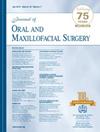Navigation-Guided Management of Comminuted Zygomaticomaxillary Complex Fracture Concurrent With Orbital Reconstruction
IF 2.3
3区 医学
Q2 DENTISTRY, ORAL SURGERY & MEDICINE
引用次数: 0
Abstract
Background
Comminuted zygomaticomaxillary complex (ZMC-C) fracture with orbital reconstruction poses challenges for surgeons. Navigation-guided technique may be valuable for surgical reduction.
Purpose
This study aimed to measure the difference error between planned and actual reduction of ZMC-C fracture with orbital reconstruction using navigation-guided technique.
Study Design, Setting, Sample
This retrospective single-arm cohort study involved subjects with ZMC-C and orbital fractures from Jan 2017 to Jun 2019 at the Department of Ophthalmology, Ninth People's Hospital, Shanghai Jiao Tong University School of Medicine, China. Subjects with brain damage, unstable vital signs, allergy to titanium alloy implants, trauma to other facial bones or postoperative facial trauma were excluded.
Main Outcome Variables
The primary outcome variable was the mean 3-dimensional (3D) (Euclidean) distance error between surgical plan and actual outcome. Secondary outcomes included mean absolute distance error in transverse, vertical and anterior–posterior planes, visual analog scale score of subjects' self-satisfaction with facial aesthetics and function, orbital volume, exophthalmometry, position of bilateral zygomatic bones and surgical complications.
Covariates
Covariates included age and sex.
Analyses
Outcomes were tested using t-tests with significance at P < .05 to determine differences between preoperative and postoperative measurements and symmetry.
Results
The sample included 20 subjects with a median age of 39 years (interquartile range = 24.5) and 19 (95%) were male. The mean 3D distance errors were 0.5 ± 0.3 mm at the midpoint of the fracture line at the zygomatic frontal suture, 0.7 ± 0.3 mm at the most prominent point on the surface of zygoma and 0.6 ± 0.4 mm at the intersection point of the zygomatic alveolar buttress and fracture line. The maximum mean absolute distance error was 0.8 ± 0.2 mm. Postoperative visual analog scale score improved in all subjects. Mean orbital volume was reduced by 2.2 ± 0.6 cm3, and enophthalmos improved to 0.4 ± 0.3 mm (all P < .01). There were no significant differences in exophthalmometry, orbital volume and position of bilateral zygomatic bones between the affected and unaffected sides (P > .05).
Conclusion and Relevance
Deficient movement in the anterior–posterior plane mainly contributes to 3D distance error. The mean distance error was clinically acceptable with the aid of navigation-guided technique in managing ZMC-C fracture with orbital reconstruction.
导航治疗粉碎性颧腋窝复合体骨折合并眶内重建。
背景:粉碎性颧腋复合体(ZMC-C)骨折伴眶重造术是外科医生面临的挑战。导航引导技术可能对手术复位有价值。目的:本研究旨在测量导航技术在ZMC-C骨折眶内重建中计划复位与实际复位的误差差。研究设计、环境、样本:本回顾性单臂队列研究纳入2017年1月至2019年6月在中国上海交通大学医学院第九人民医院眼科就诊的ZMC-C和眼眶骨折患者。排除脑损伤、生命体征不稳定、对钛合金植入物过敏、其他面部骨骼创伤或术后面部创伤的受试者。主要转归变量:主要转归变量为手术方案与实际转归之间的平均三维(欧氏)距离误差。次要结果包括横向、垂直和前后平面的平均绝对距离误差、受试者面部美观和功能自我满意度的视觉模拟量表评分、眼眶体积、眼球测量、双侧颧骨位置和手术并发症。协变量:协变量包括年龄和性别。结果:样本包括20名中位年龄为39岁的受试者(四分位数间距= 24.5),其中19名(95%)为男性。平均三维距离误差为颧额缝线骨折中点0.5±0.3 mm,颧骨表面最突出点0.7±0.3 mm,颧牙槽支撑与骨折线交点0.6±0.4 mm。最大平均绝对距离误差为0.8±0.2 mm。术后所有受试者的视觉模拟评分均有改善。平均眼眶体积减小2.2±0.6 cm3,眼球内陷改善0.4±0.3 mm(均P < 0.05)。结论及意义:前后平面运动不足是导致三维距离误差的主要原因。在导航引导下治疗ZMC-C骨折眶内重建的平均距离误差是临床可以接受的。
本文章由计算机程序翻译,如有差异,请以英文原文为准。
求助全文
约1分钟内获得全文
求助全文
来源期刊

Journal of Oral and Maxillofacial Surgery
医学-牙科与口腔外科
CiteScore
4.00
自引率
5.30%
发文量
0
审稿时长
41 days
期刊介绍:
This monthly journal offers comprehensive coverage of new techniques, important developments and innovative ideas in oral and maxillofacial surgery. Practice-applicable articles help develop the methods used to handle dentoalveolar surgery, facial injuries and deformities, TMJ disorders, oral cancer, jaw reconstruction, anesthesia and analgesia. The journal also includes specifics on new instruments and diagnostic equipment and modern therapeutic drugs and devices. Journal of Oral and Maxillofacial Surgery is recommended for first or priority subscription by the Dental Section of the Medical Library Association.
 求助内容:
求助内容: 应助结果提醒方式:
应助结果提醒方式:


